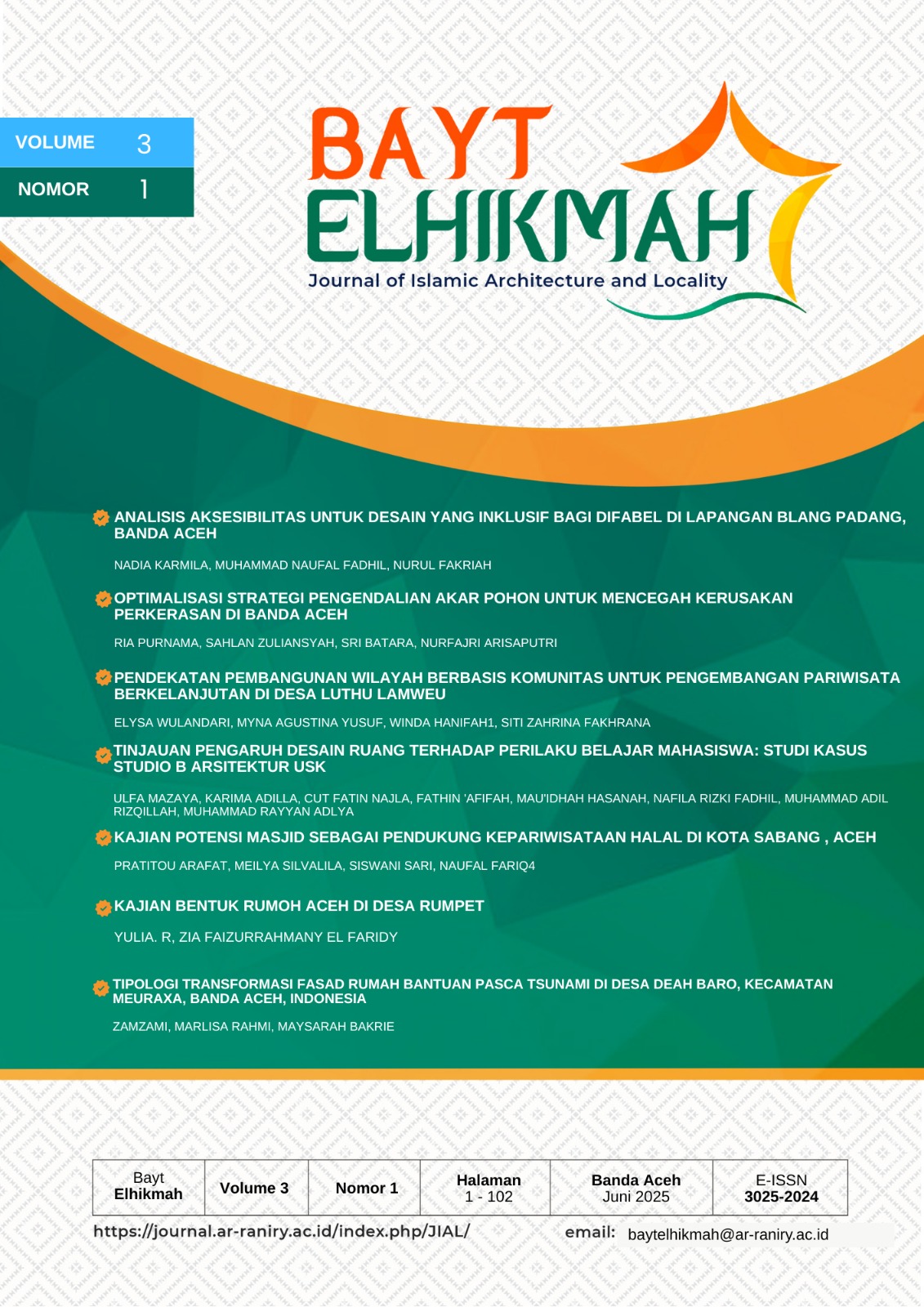Optimalisasi Strategi Pengendalian Akar Pohon untuk Mencegah Kerusakan Perkerasan di Banda Aceh
DOI:
https://doi.org/10.22373/jial.v3i1.7997Keywords:
Vegetasi kota, kerusakan perkerasan, akar pohon, Banda AcehAbstract
Kerusakan infrastruktur perkotaan seperti jalan, trotoar, dan drainase akibat pertumbuhan akar pohon menjadi tantangan besar dalam pembangunan infrastruktur dan ruang terbuka hijau di kota yang sedang berkembang seperti Banda Aceh. Studi ini dilakukan untuk mengidentifikasi kerusakan infrastruktur perkotaan terkait akar pohon, serta strategi penanaman dan perawatan pohon, terutama terkait pengendalian akar, yang dapat menyelesaikan persoalan tersebut. Metode yang digunakan meliputi observasi dan dokumentasi lapangan di beberapa titik kota yang mengalami kerusakan perkerasan, serta studi dan analisis literatur terhadap praktik manajemen akar yang terbukti mampu menyelesaikan permasalahan tersebut secara konsisten dan komprehensif. Hasil pengamatan lapangan menunjukkan bahwa pertumbuhan akar pohon yang agresif akibat teknik penanaman dan perawatan pohon yang belum tepat serta minimnya strategi pengendalian akar menjadi penyebab utama kerusakan perkerasan di kawasan urban Banda Aceh. Berdasarkan studi terhadap praktik pengendalian akar pohon pada kota-kota maju di dunia, ditemukan beberapa solusi yang dapat diadaptasi, meliputi pemilihan tanaman non-invasif, penggunaan teknik penyiraman dan jarak tanam yang tepat, serta penggunaan teknologi mitigasi akar seperti tree pit, tree trench, root barrier, dan structural soil.
References
Bowler, D. E., Buyung-Ali, L., Knight, T. M., & Pullin, A. S. (2010). Urban greening to cool towns and cities: A systematic review of the empirical evidence. Landscape and Urban Planning, 97(3), 147–155.
Clark, M., Jones, T., & Evans, S. (2019). Structural Soil for Urban Trees: Innovations in Design. Journal of Urban Horticulture, 8(2), 123–135.
Coutts, A. M., Beringer, J., & Tapper, N. J. (2013). Characteristics influencing the cooling capacity of urban landscapes: A case study of Melbourne, Australia. Urban Forestry & Urban Greening, 12(3), 334–341.
Creswell, J. W. (2014). Research design: Qualitative, quantitative, and mixed methods approaches (4th ed.). Sage Publications.
DeepRoot Green Infrastructure. (2023). Tree watering bags: Are they worth using? https://www.deeproot.com/blog/blog-entries/tree-watering-bags-are-they-worth-using
Dimoudi, A., & Nikolopoulou, M. (2003). Vegetation in the urban environment: microclimatic analysis and benefits. Energy and Buildings, 35(1), 69–76.
Fredrick, C., Ekeke, B. A., Omokhua, G. E., & Alex, A. (2021). Assessment of the effect of cutting length on sprout and growth of Pterocarpus santalinoides L’Hérit. ex DC. Journal of Applied Life Sciences International, 24(9), 1–9.
Gilbert, A., Brown, R., & White, D. (2018). Root Barrier Technology for Urban Tree Management. Arboriculture and Urban Forestry, 44(3), 145–159.
Gilman, E. F. (1990). Tree root growth and development. Journal of Arboriculture, 16(8), 203-207.
Goh, E. G., & Ahmad, M. F. (2025). Soil compaction and root growth: A review. Soil and Tillage Research.
Grabosky, J., & Bassuk, N. (1995). A new urban tree soil to safely increase rooting volume. Journal of Arboriculture, 21(4), 187–201.
Herbst, M., Lenz, J., & Clark, J. R. (2019). Contemporary concepts of root system architecture of urban trees. Arboriculture & Urban Forestry, 36(4), 149–?
Ho, M. D., McCannon, B. C., & Lynch, J. P. (2018). Root traits as drivers of plant and ecosystem functioning: Current perspectives. New Phytologist.
ISA. (2018). Best management practices: Managing trees during construction. International Society of Arboriculture.
James, J., Hartley, M., & O’Sullivan, K. (2014). Managing urban tree root damage to pavements: A review of current practices. Urban Forestry & Urban Greening, 13(3), 659–670.
Kumar, R., Ganesh, S., Chithiraichelvan, R., Upreti, K. K., & Sulladmath, V. V. (2014). Effect of spacing and pruning on growth, yield and quality of cv. Deanna fig (Ficus carica L.). Journal of Horticultural Science, 9(2), 115–119.
Livesley, S. J., McPherson, E. G., & Calfapietra, C. (2016). The urban forest and ecosystem services: Impacts on urban water, heat, and pollution cycles at the tree, street, and city scale. Journal of Environmental Quality, 45(1), 119–124.
Merriam, S. B., & Tisdell, E. J. (2015). Qualitative research: A guide to design and implementation (4th ed.). Jossey-Bass.
Meutia, Z. D., Trimafika, S., & Darnas, Y. (2024). Capability Of Green Open Space Vegetation Reducing Carbon Emissions In The Transportation Sector (Xase Study Of The Simpang jam Area In Banda Aceh City). Indonesian Journal of Environmental Sustainability, 2(1), 52-58.
Nowak, D. J., Crane, D. E., & Stevens, J. C. (2006). Air pollution removal by urban trees and shrubs in the United States. Urban Forestry & Urban Greening, 4(3-4), 115–123.
NParks. (2017). Street tree management guidelines. National Parks Board Singapore.
Rahman, M. A., Moser, A., Rötzer, T., & Pauleit, S. (2017). Within canopy temperature differences and cooling ability of Tilia cordata trees grown in confined and unconfined soil volumes. Building and Environment, 114, 118–128.
Rahman, M. A., Stringer, P., & Ennos, A. R. (2013). Effect of pit design on growth and root architecture of urban trees in the establishment phase. Arboriculture & Urban Forestry, 39(6), 291–299.
Rahman, M. M., Roberts, J., & Thomas, N. (2017). Root management technologies for urban trees: A review. Urban Forestry & Urban Greening, 23, 11–20. https://doi.org/10.1016/j.ufug.2017.02.007
Rahman, M., Huxley, A., & Ennos, A. R. (2017). Tree root barriers: effects on root growth and infrastructure damage. Trees, 31(6), 1973–1984.
Sachs, T. (2017). Green Infrastructure in European Cities: Case Studies of Sustainable Urban Tree Planting. Landscape and Urban Planning, 160, 45–58.
Smiley, E. T. (2008). Root barriers: Specifications and applications. Arboriculture & Urban Forestry, 34(1), 56-59.
Smith, R. (2020). Effective Tree Planting Strategies in Dense Urban Areas: A Review of European Practices. Urban Ecology, 5(1), 12–22.
Thomas, D. (2018). Tropical Urban Tree Planting: Challenges and Solutions for Tropical Cities. Environmental Science and Policy, 90, 101–110.
Tumber-Dávila, S. J., Trugman, A. T., Anderegg, W. R. L., McDowell, N. G., & Asner, G. P. (2023). Deep root water uptake contributes significantly to tree drought resilience. Frontiers in Plant Science, 14, 1275464. https://doi.org/10.3389/fpls.2023.1275464
University of Nebraska–Lincoln. (2023). Efficient and effective tree watering. Water.unl.edu. https://water.unl.edu/article/lawns-gardens-landscapes/efficient-and-effective-tree-watering
USDA. (2020). Urban tree guide. United States Department of Agriculture.
Vogt, J., et al. (2015). Tree root management in urban environments: A review of methods and technologies. Environmental Management, 56(2), 324–337.
WaterLyst. (2023). Sprinkler irrigation efficiency methods. https://waterlyst.com/articles/sprinkler-irrigation-efficiency-methods
Yan, M., He, X., Wang, Y., & Yang, C. (2024). Response of apple trees to regulated deficit drip irrigation in arid regions. Agricultural Water Management, 292, 108095. https://doi.org/10.1016/j.agwat.2024.108095
Yin, R. K. (2018). Case study research and applications: Design and methods (6th ed.). Sage Publications.
Yulisma, S., & Aulia, D. N. (2019). Kriteria vegetasi untuk RTH jalur jalan dan jalur pejalan kaki. Jurnal Ilmiah, 5(2), 45–58.
Zhang, C., Stratópoulos, L. M. F., Xu, C., Pretzsch, H., & Rötzer, T. (2020). Development of fine root biomass of two contrasting urban tree cultivars in response to drought stress. Forests, 11(1), 108. https://doi.org/10.3390/f11010108
Zuliansyah, S. (2018). Potential analysis on strategy and impact of vegetative measures for high urban temperature mitigation in Banda Aceh, Indonesia (Master’s Thesis, HafenCity University Hamburg, Resource Efficiency in Architecture and Planning).




















